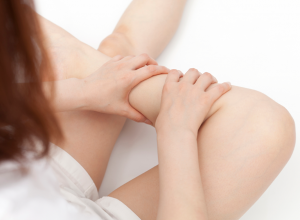
Peripheral Arterial Disease
A common circulatory problem, peripheral arterial disease (sometimes called critical limb ischemia) happens when narrowed or clogged arteries reduce blood flow to the body’s limbs. PAD usually affects the legs and can cause pain while walking. It’s most often treated with diet, exercise and a reduction of tobacco.
Symptoms
PAD rarely shows symptoms, but if it does, pain in the legs while walking (intermittent claudication) is one of the most common signs. Due to reduced blood flow to the extremities, intermittent claudication causes muscle pain and cramps most noticeable during physical activity. Calf pain is the most common location.
Other symptoms associated with peripheral arterial disease include leg numbness or weakness, cold feet, sores or ulcers on your toes and feet that don’t heal, skin color changes in your legs and feet, hair loss on the feet and legs, shiny skin on your legs, and a weak pulse (or no pulse) in your feet and legs. Some men with PAD experience erectile dysfunction.
When PAD progresses, patients may experience pain even at rest or when lying down (ischemic rest pain), arterial insufficiency ulcers and gangrene. This advanced stage of peripheral arterial disease is called Critical Limb Ischemia, or limb threat.
Causes
PAD is often sign of widespread fatty deposits in your arteries (atherosclerosis), which can reduce blood flow to your limbs, heart and brain. Other causes include blood vessel inflammation, limb injury, unusual anatomy of your muscles or ligaments or radiation exposure, as well as smoking, diabetes, obesity, high cholesterol, age and high levels of homocysteine (a protein compound that builds and maintains tissue).
People who smoke or have diabetes are at the highest risk of developing peripheral arterial disease, as both reduce blood flow to the extremities. The National Heart, Lung, and Blood Institute (NHLBI) states that African Americans are also at great risk and are twice as likely to develop PAD than Caucasians.
Treatment
Usually peripheral arterial disease can be successfully treated simply by adhering to a healthy diet, exercising and reducing the use of tobacco and nicotine products. However, if these conservative treatments fail, your doctor may recommend medications that help prevent blood clots, lower blood pressure and cholesterol and control pain. In rare cases, surgery or an angioplasty (surgical unblocking of a blood vessel or artery) may be necessary.
Because PAD is one of the leading causes of death in the United States, vascular experts called interventional radiologists are increasingly partnering with primary health care professionals to bring widespread knowledge of the disease the public and increase early screening.
Anyone diagnosed with peripheral arterial disease is strongly recommended to pay special attention to their feet, especially if it’s in conjunction with diabetes. Poor blood circulation can affect healing rates of sores and wounds on the feet, which can lead to infection, gangrene and even limb amputation.
Ways to properly take care of the feet include making sure they are thoroughly washed and dried on a daily basis, wearing well-fitting shoes and dry socks, properly trimming the nails, having a podiatrist treat corns and calluses and seeing a doctor at the first sign of a sore, cut, ulcer or injury to the skin.
Notice concerning medical entries:
Articles having medical content shall serve exclusively for the purpose of general information. Such articles are not suitable for any (self-) diagnosis and treatment of individual illnesses and medical indications. In particular, they cannot substitute for the examination, advice, or treatment by a licensed physician or pharmacist. No replies to any individual questions shall be effected through the articles.








